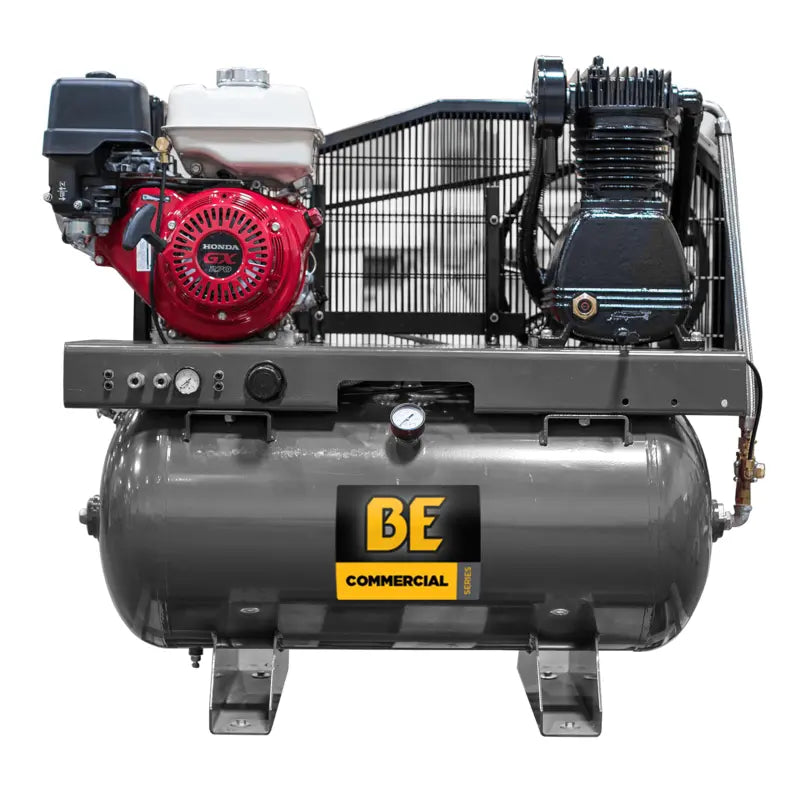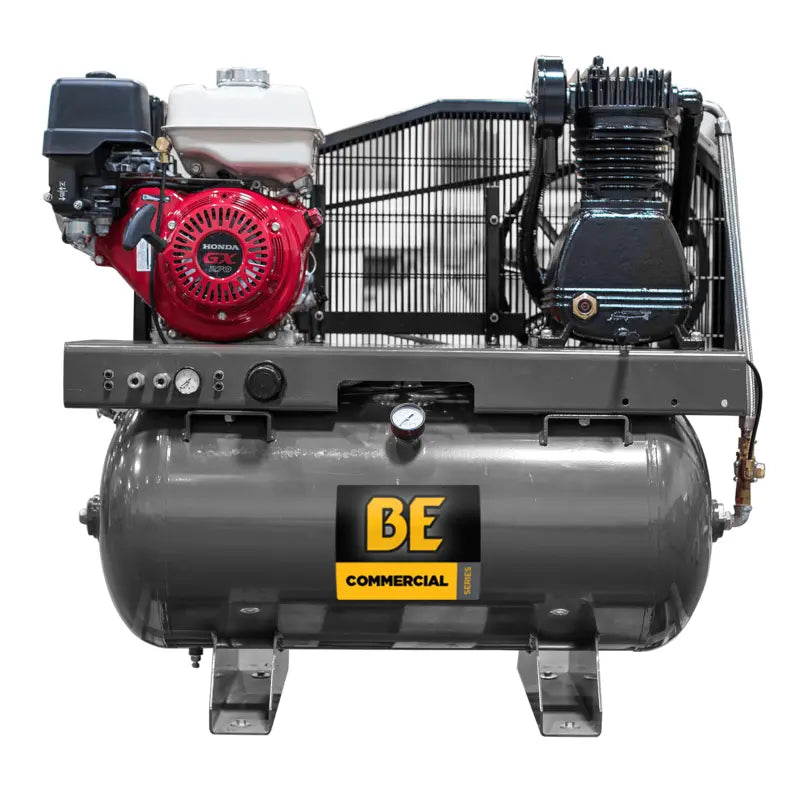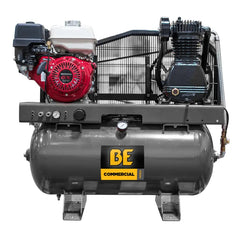Product
Description
Pro Grade Air Power for All Day, Every Day
The AC930HB Gas Air Compressor from BE Power Equipment is built for serious pros who need reliable, high output compressed air in the field or on the jobsite. 16 CFM @ 175 PSI, truck mount ready with a commercial grade Honda GX270 engine, heavy duty two stage pump and 30 gallon horizontal tank for all day use. Whether you’re framing, roofing, sandblasting or running multiple tools at once the AC930HB is designed to perform day in and day out.
Built for truck and trailer mounting this compressor has oversized tank brackets for maximum stability, removable saddle for configuration flexibility and Conrader pilot valve controls for precise PSI regulation. It’s the go to compressor for contractors, mobile repair techs and industrial crews who need power in remote or demanding environments.
Features
-
16 CFM @ 175 PSI – Air volume and pressure for pro tools and applications
-
Honda GX270 Engine – Commercial grade powerplant with best in class reliability and performance
-
Heavy Duty Two Stage Pump – Cast iron construction, splash lubricated, built to last
-
Belt Drive System – Lowers pump RPM to reduce heat and wear
-
Conrader Pilot Valve – Cuts in at 140 PSI and out at 175 PSI for automatic pressure control
-
30 Gallon Horizontal Tank – Truck mount ready with oversized support brackets
-
Removable Saddle Mount – Allows custom setups by separating tank from engine/pump assembly
-
Factory Tested – Every unit is performance tested before shipping
Powered by the Legendary Honda GX270 Engine
At the heart of the AC930HB is the Honda GX270, a 270cc 4 stroke OHV engine trusted by pros worldwide for its unbeatable durability, fuel efficiency and cold start dependability. Designed for commercial use the GX270 features:
-
Excellent weight to power ratio
-
Low oil shutdown sensor for engine protection
-
Heavy duty air filter and muffler
-
Smooth and quiet operation with minimal vibration* Proven in hot, dusty or demanding environments
This engine runs all day, every day — just what commercial air users need.
Belt Drive System for Cooler, Longer Life
Direct drive compressors spin at high RPM and generate heat. The AC930HB uses a belt drive system to lower the pump speed and extend component life. Benefits include:
-
Less wear on pump components
-
Lower operating temps even during long runtimes
-
Quieter operation than high speed compressors
-
Easier pump servicing and belt tension adjustments
This way your compressor delivers high volume air without sacrificing durability.
Heavy Duty Two Stage Pump
Built to last the two stage splash lubricated pump has:
-
Cast iron cylinders for superior heat dissipation and long life
-
Accessible valves and service points for easy maintenance
-
Bearings on both ends of the crankshaft for balanced rotation and reduced wear
-
Precision machined components for high efficiency compression
Two stage compression compresses air in two steps allowing for higher PSI output and better heat control than single stage models — perfect for pros using high demand tools or running multiple lines.
USA Made Conrader Pilot Unloader Valve
This unit comes with a factory installed Conrader pilot unloader valve — a US made control system that regulates pressure precisely and safely:
-
Cut in pressure: 140 PSI
-
Cut out pressure: 175 PSI
-
Allows the engine to run continuously while regulating pressure to the tank
-
Allows seamless operation during tool usage and idle cycles
It’s one of the most trusted pilot valves in the industry — and it comes standard on the AC930HB.
30 Gallon Horizontal Tank – Truck Mount Ready
The 30 gallon horizontal tank is designed for truck mounting with oversized brackets for maximum stability during transport and operation. Perfect for:
-
Service trucks and trailers
-
Jobsite setups with limited floor space
-
Industrial applications that require mobile air supply
The tank’s horizontal layout keeps the center of gravity low and increases mounting options for different vehicles or rigs.
Removable Saddle for Custom Installations
Need to set up your compressor differently? No problem.## Removable Saddle for Custom Installations
Need to set up your compressor differently? No problem. The removable saddle lets you separate the pump and engine from the tank, so you can mount each component where it fits best — inside a service compartment, under a utility body, or on a custom trailer deck.
This feature also makes the unit easier to service and simpler to integrate into unique tool setups.
Professional Design and User-Friendly Features
-
Heavy-duty frame with powder-coated finish for corrosion resistance
-
Integrated vibration mounts reduce engine and pump movement
-
Convenient access points for air lines, oil fills, and maintenance
-
Factory-assembled and tested for reliability right out of the box
Note: Because BE Power Equipment tests all air compressors prior to shipping, units may contain minimal residual oil and/or fuel odor. Product appearance may vary slightly from images shown.
Product Specifications
-
CFM @ 175 PSI: 16 CFM
-
Maximum Pressure: 175 PSI
-
Engine: Honda GX270, 270cc, 4-stroke OHV
-
Pump: Two-stage, splash-lubricated, cast iron
-
Belt drive system
-
Less wear on pump components
-
Lower operating temps
-
Quieter operation
-
-
Unloader Valve: Conrader pilot valve (cut-in 140 PSI, cut-out 175 PSI)
-
Tank Size: 30 gallons
-
Tank Style: Horizontal, truck-mountable with oversized brackets
-
Frame: Steel with removable saddle
-
Safety Features:
-
Automatic low oil shutdown
-
Pressure relief valves
-
Belt guard
-
-
Shipping Weight: 471 lbs
-
Dimensions (LxWxH): 52" x 25" x 50"
Built for the Professional, Proven in the Field
Whether you’re using high demand tools or running multiple lines, the AC930HB Gas Air Compressor has got you covered. Proven in hot, dusty or demanding environments.
Compare Air Compressor
|
ENGINE
|
Honda GX270 | - | - |
|
CC
|
270 | - | - |
|
PSI
|
16 CFM @ 175 PSI | - | - |
|
ENGINE START
|
Recoil | - | - |





